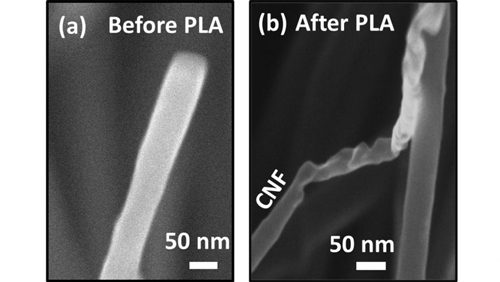
Research from North Carolina State University has demonstrated a new technique that converts carbon fibers and nanotubes into diamond fibers at ambient temperature and pressure in air using a pulsed laser method.
The conversion method involves melting the carbon using nanosecond laser pulses and then quenching, or rapidly cooling, the material.
These diamond fibers could find uses in nanoscale devices with functions ranging from quantum computing, sensing and communication to diamond brushes and field-emission displays. The method can also be used to create diamond-seeded carbon fibers that can be used to grow larger diamond structures using hot-filament chemical vapor deposition and plasma-enhanced chemical vapor deposition techniques. These larger diamond structures could find uses as tool coatings for oil and gas exploration as well as deep-sea drilling, and for diamond jewelry.
Previous methods used to convert non-diamond carbon to diamond have involved using extreme heat and pressure at great expense with a limited yield. Melting the carbon with laser pulses and then undercooling it with a substrate made of sapphire, glass or a plastic polymer are the two keys to the discovery, said Dr. Jagdish Narayan, John C. Fan Distinguished Chair Professor in the Department of Materials Science and Engineering at NC State and corresponding author of a paper describing the work.
“Without undercooling, you cannot convert carbon into diamond this way,” Narayan said.
When heated, carbon normally goes from a solid state to a gas. Using a substrate restricts heat flow from the laser pulse enough that the carbon does not change phases.
The laser, similar to those used for Lasik eye surgery, is used for only 100 nanoseconds and heats the carbon to a temperature of 4,000 Kelvin, about 3,727 degrees Celsius.
NC State has filed for a patent licensing the technology.
The paper, “Direct conversion of carbon nanofibers and nanotubes into diamond nanofibers and subsequent growth of large-size diamonds,” is published in Nanoscale, a journal of the Royal Society of Chemistry. The paper was coauthored by Anagh Bhaumik, a research assistant in the Narayan lab; Dr. Ritesh Sachan, an assistant professor at Oklahoma State University and former researcher in the Narayan lab; Ariful Haque and Siddarth Gupta, graduate students in the lab; and Dr. Punam Pant, a research scientist in the Narayan lab. The research was done with support from the National Science Foundation, under grant number DMR 1735695.
Note to Editors: The paper title and abstract follow.
“Direct Conversion of Carbon Nanofibers and Nanotubes into Diamond Nanofibers and Subsequent Growth of Large-sized Diamonds”
Authors: Jagdish Narayan, Anagh Bhaumik, Ariful Haque, Siddarth Gupta, Punam Pant, North Carolina State University; Ritesh Sachan, Oklahoma State University
Published: Jan. 2, Nanoscale
DOI: 10:1039/C8NR08823C
Abstract: We report a pulsed laser annealing method to convert carbon fibers and nanotubes into diamond fibers at ambient temperature and pressure in air. The conversion of carbon nanofibers and nanotubes into diamond nanofibers involves melting in a super undercooled state using nanosecond laser pulses, and quenching rapidly to convert into phase-pure diamond. The conversion process occurs at ambient temperature and pressure, and can be carried out in air. The structure of diamond fibers has been confirmed by selected-area electron diffraction in transmission electron microscopy, electron-back-scatter-diffraction in high-resolution scanning electron microscopy, all showing characteristic diffraction lines for the diamond structure. The bonding characteristics were determined by Raman spectroscopy with a strong peak near 1332 cm−1, and high-resolution electron-energy-loss spectroscopy in transmission electron microscopy with a characteristic peak at 292 eV for σ* for sp3 bonding and the absence of π* for sp2 bonding. The Raman peak at 1332 cm−1 downshifts to 1321 cm−1 for diamond nanofibers due to the phonon confinement in nanodiamonds. These laser-treated carbon fibers with diamond seeds are used to grow larger diamond crystallites further by using standard hot-filament chemical vapor deposition (HFCVD). We compare these results with those obtained without laser treating the carbon fibers. The details of diamond conversion and HFCVD growth are presented in this paper.
Original Posting: https://news.ncsu.edu/2019/01/new-method-allows-direct-conversion-of-carbon-fibers-and-nanotubes-into-diamond-fibers/